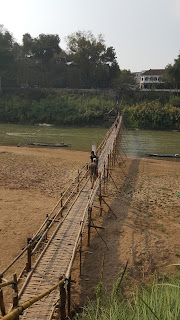It’s 8 a.m. The air is still cool at 16C.
It has been rather cold at night for the last 1 week when temperature dipped to as
low as 11C. Fortunately in the afternoon, it warmed up to the mid 20’s.
We walked toward the boat pier where
the long boats also called “slow boats” are docked 4 abreast. They will take us to Pak Ou Cave. This river boats are long and narrow and seat up to 10 paxs, seated 2 abreast. Pak Ou is
25km upstream and will take about 2 hours.
The boat cruised upstream on the muddy water of the Mekong River. This waterway is the economic lifeline
of the Laotians. The place seem to be thinly populated with a few isolated villages along both sides of the river. Many small
fishing boats as well as larger ferry boats are anchored along the shores. I even saw some women doing their laundry on the river bank. Traffic
on the river was rather lull.
The cruise along the Mekong River was serene
except for the engine noise. The view was picturesque and hills on the
background were still covered with some mist. Some part of the river was shallow
with pocket of beautiful rocks exposed. The boatman has to skilfully meander through
these rocks.
We finally arrived at Pak Ou cave after 2 hours ride and disembarked on a rickety bamboo jetty.
The description of Pak Ou caves from Laos’s
official website site below:
Pak Ou translates to
‘mouth of the Ou River’ with the first cave entrance of Tham Ting being very
visible from the water; the higher cave is accessed by stairs. The Buddha
images in the Pak Ou Caves assume a variety of positions, from meditation to
peace and nirvana (the reclining Buddha). Both caves are shrines to Buddha,
offering places of worship with the largest image in Tham Ting being a popular
place to burn incense and offer prayers. The smaller cave is the more peaceful,
with glimpses of the Mekong providing a breathtaking backdrop. The caves are a
very popular pilgrim site for locals and get very busy during April when the
Lao New Year is in full swing with locals washing and attending to the images.
We also visit a Laotian village famous
for Laos silk weaving as well was brewing of Laos whiskey.
I visited another village where we need to
cross the Nam Khan River on a bamboo bridge built by the indigenous Laotians. There is a fee payable for the use of this bamboo bridge.






























































